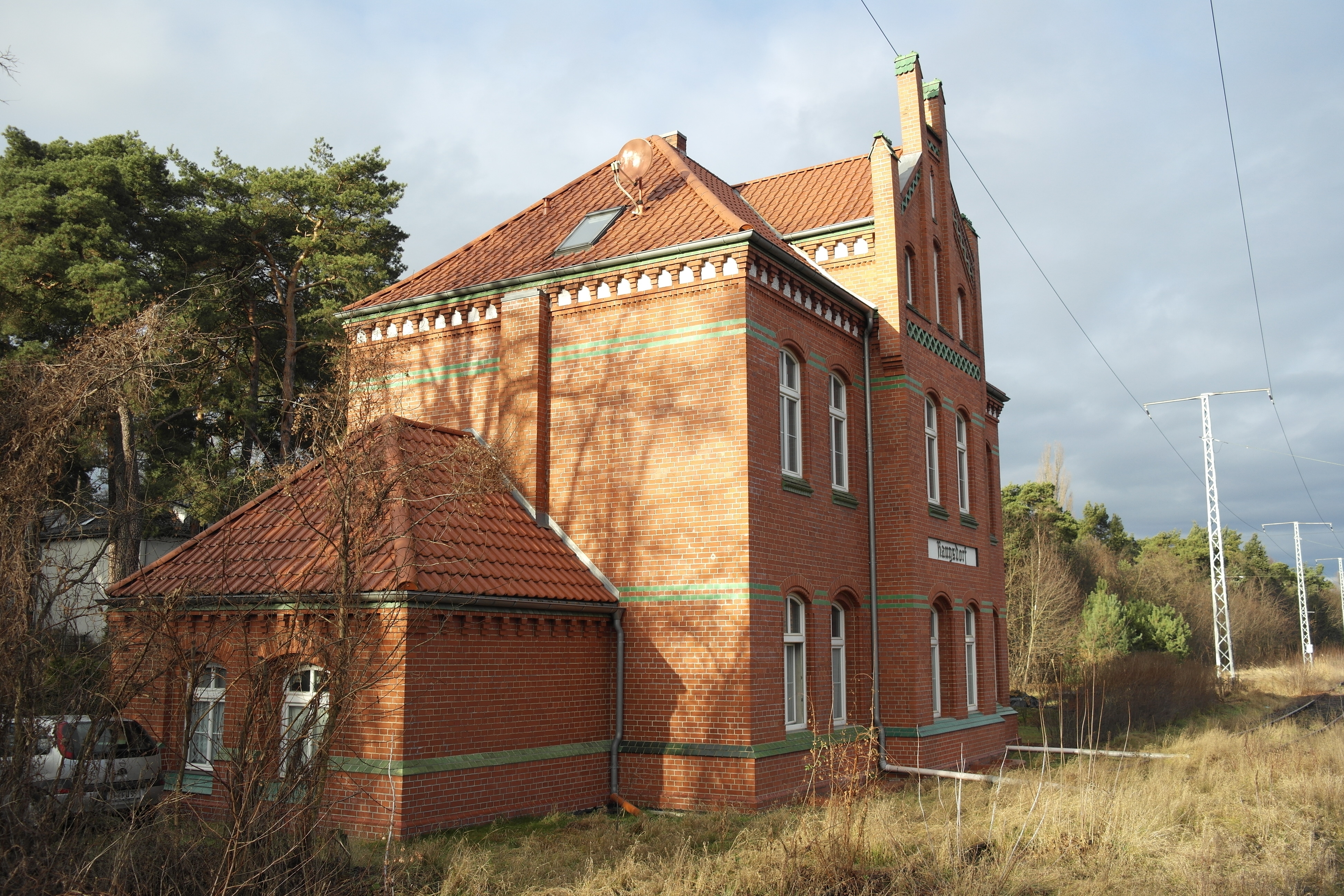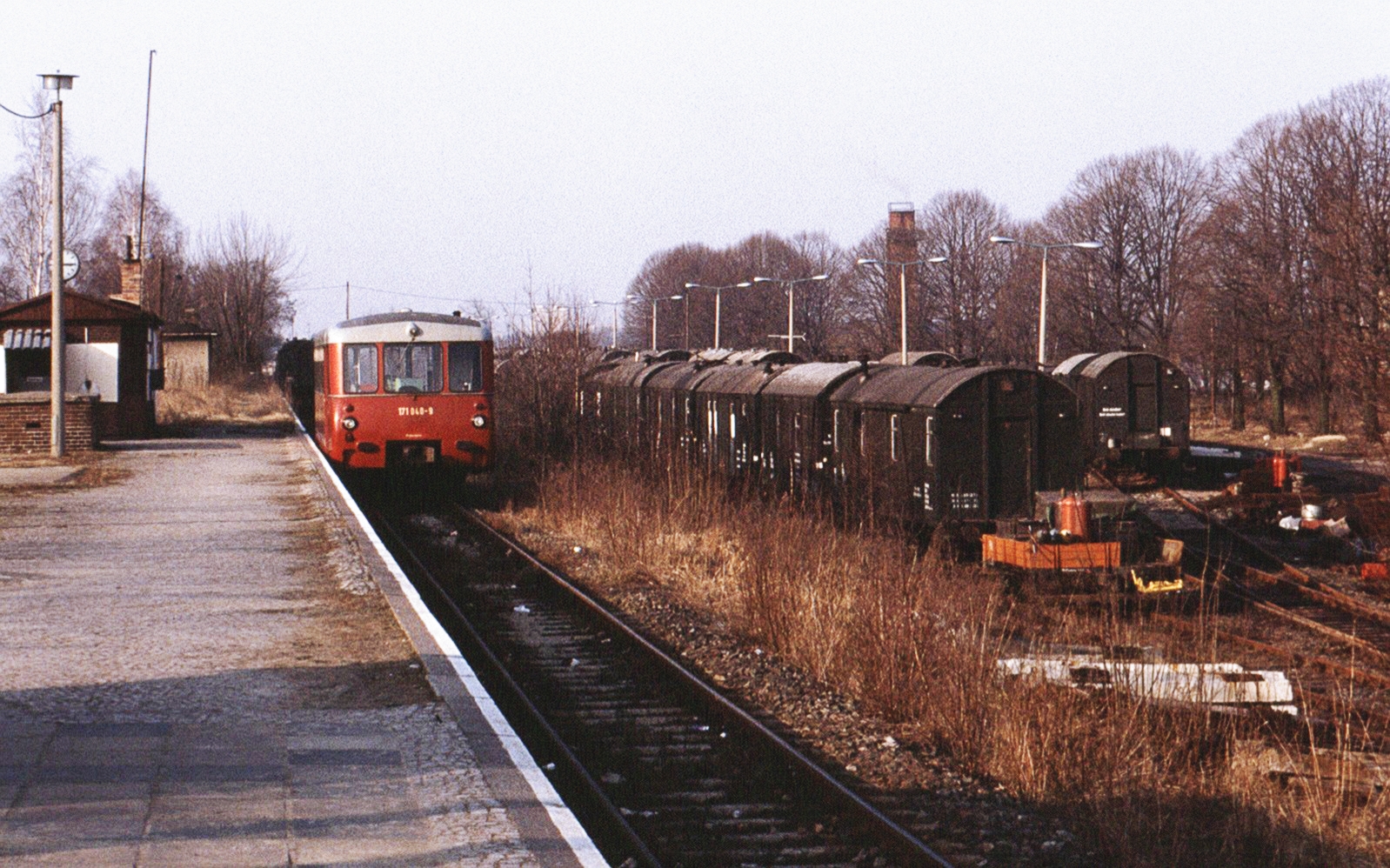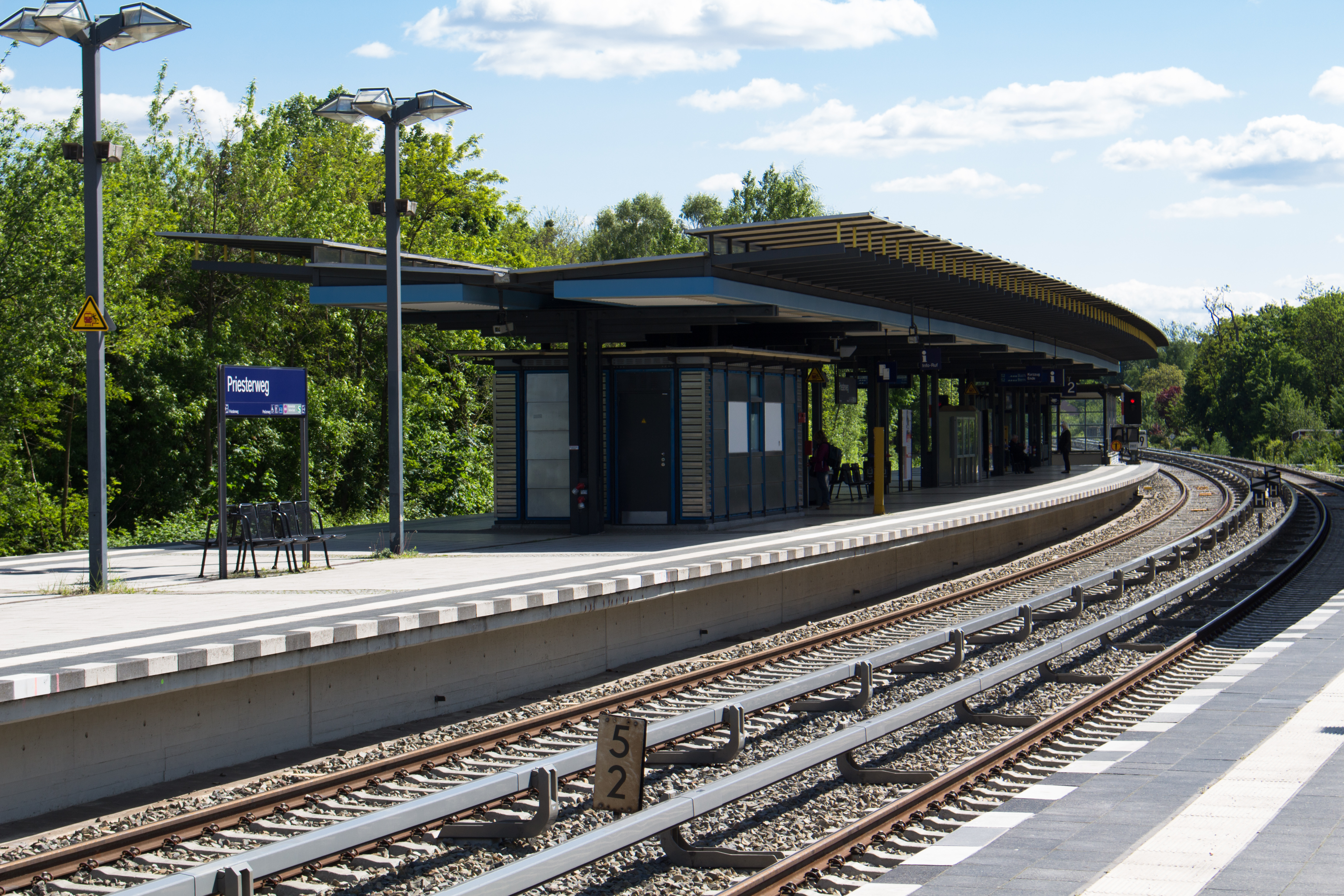|
Rangsdorf Railway Station
Rangsdorf station is a station in the locality of Rangsdorf in the district of Teltow-Fläming in the German state of Brandenburg. It is located at kilometre 24.3 of Berlin–Dresden railway. Until 1919, the western part of the station was served by the Royal Prussian Military Railway. Location and infrastructure The station is located in Fontaneplatz to the west of the centre of the village of Rangsdorf. It is at ground level and consists of three platforms for passenger traffic. The entrance building of the former Military Railway is located to the west of the tracks and is now used as a residential building. The entrance building of the former Berlin-Dresden railway is located on the eastern side. A third entrance was built at the southern end during the development of the former Military Railway platform for suburban traffic in 1940. A footbridge connects the platforms and both sides of the station. The military station, which was later developed as a suburban station is list ... [...More Info...] [...Related Items...] OR: [Wikipedia] [Google] [Baidu] |
Rangsdorf
Rangsdorf is a Municipalities of Germany, municipality in the district of Teltow-Fläming in Brandenburg in Germany. It has an airfield [up to 1940 a genuine commercial airport] from where on 20 July 1944 Claus Schenk Graf von Stauffenberg took off on his fateful attempt to assassinate German leader Adolf Hitler at his military headquarters in East Prussia, the ''Wolfsschanze''. Demography File:Bevölkerungsentwicklung Rangsdorf.pdf, Development of Population since 1875 within Current Boundaries (Blue Line: Population; Dotted Line: Comparison to Population Development of Brandenburg state; Grey Background: Time of National Socialist rule; Red Background: Time of Communist rule) File:Bevölkerungsprognosen Rangsdorf.pdf, Recent Population Development and Projections (Population Development before Census 2011 (blue line); Recent Population Development according to the Census in Germany in 2011 (blue bordered line); Official projections for 2005-2030 (yellow line); for 2020-2030 (gr ... [...More Info...] [...Related Items...] OR: [Wikipedia] [Google] [Baidu] |
Wünsdorf-Waldstadt Station
Wünsdorf-Waldstadt (german: Bahnhof Wünsdorf-Waldstadt) is a railway station in the town of Wünsdorf, Brandenburg, Germany, on the Berlin–Dresden railway The Berlin–Dresden railway is a double track, electrified main line railway in the German states of Berlin, Brandenburg and Saxony, which was originally built and operated by the ''Berlin-Dresden Railway Company'' (''Berlin-Dresdener Eisenbahn- ..., with services operated by Deutsche Bahn. Train services The station is served by the following services: *Regional services ''Rostock / Stralsund – Neustrelitz – Berlin – Wünsdorf-Waldstadt – Elsterwerda'' *Regional servic ... [...More Info...] [...Related Items...] OR: [Wikipedia] [Google] [Baidu] |
Railway Stations In Brandenburg
Rail transport (also known as train transport) is a means of transport that transfers passengers and goods on wheeled vehicles running on rails, which are incorporated in Track (rail transport), tracks. In contrast to road transport, where the vehicles run on a prepared flat surface, rail vehicles (rolling stock) are directionally guided by the tracks on which they run. Tracks usually consist of steel rails, installed on Railroad tie, sleepers (ties) set in track ballast, ballast, on which the rolling stock, usually fitted with metal wheels, moves. Other variations are also possible, such as "slab track", in which the rails are fastened to a concrete foundation resting on a prepared subsurface. Rolling stock in a rail transport system generally encounters lower friction, frictional resistance than rubber-tyred road vehicles, so passenger and freight cars (carriages and wagons) can be coupled into longer trains. The rail transport operations, operation is carried out by a ... [...More Info...] [...Related Items...] OR: [Wikipedia] [Google] [Baidu] |
List Of Railway Stations In Brandenburg
This list covers all passenger railway stations and halts in Brandenburg that are used by scheduled and seasonal traffic. Description The list is organised as follows: * ''Name'': the current name of the station or halt. * ''Urban/Rural county (''Kreis'')'': This column shows the county in which the station is located. The abbreviations used correspond to those used for German car number plates. The individual counties in Brandenburg are: * Barnim (''BAR'') * Brandenburg (Havel) (''BRB'') * Cottbus (''CB'') * Dahme-Spreewald (''LDS'') * Elbe-Elster (''EE'') * Frankfurt (Oder) (''FF'') * Havelland (''HVL'') * Märkisch-Oderland (''MOL'') * Oberhavel (''OHV'') * Oberspreewald-Lausitz (''OSL'') * Oder-Spree (''LOS'') * Ostprignitz-Ruppin (''OPR'') * Potsdam (''P'') * Potsdam-Mittelmark (''PM'') * Prignitz (''PR'') * Spree-Neisse (''SPN'') * Teltow-Fläming (''TF'') * Uckermark (''UM'') * ''Railway operator'': Several stations in Brandenburg are run by the ''Verkehrsverbund Ber ... [...More Info...] [...Related Items...] OR: [Wikipedia] [Google] [Baidu] |
Federal Railway Authority
The German Federal Railway Authority (german: Eisenbahn-Bundesamt, ) has been the independent federal authority for the regulation of the railways in Germany since 1 January 1994. It is under the supervision and direction of the Federal Ministry for Digital and Transport and is headed by a president. Responsibilities The EBA is the inspectorate and authorising body for the majority of German domestic, railway infrastructure companies that are owned by the government, referred to as federal railways (''Eisenbahnen des Bundes'' or ''EdB''), and for German and foreign railway transport operators in Germany. Non federally owned public railways and privately operated railways are under the supervision of the German states ('' Bundesländer''), who can choose to transfer this responsibility to the EBA (§ 5 Abs. 2 AEG). To date 11 states, with the exception of Berlin, Bremen, Hamburg, Hesse and Lower Saxony have chosen to do so. In such cases the EBA works ... [...More Info...] [...Related Items...] OR: [Wikipedia] [Google] [Baidu] |
Third Rail
A third rail, also known as a live rail, electric rail or conductor rail, is a method of providing electric power to a railway locomotive or train, through a semi-continuous rigid conductor placed alongside or between the rails of a railway track. It is used typically in a mass transit or rapid transit system, which has alignments in its own corridors, fully or almost fully segregated from the outside environment. Third rail systems are usually supplied from direct current electricity. Modern tram systems, street-running, avoid the risk of electrocution by the exposed electric rail by implementing a segmented ground-level power supply, where each segment is electrified only while covered by a vehicle which is using its power. The third-rail system of electrification is not related to the third rail used in dual gauge railways. Description Third-rail systems are a means of providing electric traction power to trains using an additional rail (called a "conductor rail") fo ... [...More Info...] [...Related Items...] OR: [Wikipedia] [Google] [Baidu] |
Mahlow Station
Mahlow station is a station in the town of Mahlow in the municipality of Blankenfelde-Mahlow in the district of Teltow-Fläming in the German state of Brandenburg. It is on the Berlin–Dresden suburban line and is served by Berlin S-Bahn line S2. Location The station is located in the centre of the town of Mahlow at kilometre 16.8 of the Berlin–Dresden railway, a few hundred metres inside the Berlin Outer Ring (''Berliner Außenring'', BAR). History The Mahlow station was opened along with the Dresden Railway on 17 June 1875. Electric S-Bahn trains ran to Mahlow from 15 May 1939 and the S-Bahn connection was extended to Rangsdorf in October 1940. The station building was hit and badly damaged in air raids in 1943. S-Bahn traffic from the north was cut off by the construction of the Berlin Wall in August 1961. A shuttle service was operated south to Rangsdorf, but it was closed in September 1961. Instead an existing service between Rangsdorf and Wünsdorf was extended to ... [...More Info...] [...Related Items...] OR: [Wikipedia] [Google] [Baidu] |
Berlin Wall
The Berlin Wall (german: Berliner Mauer, ) was a guarded concrete barrier that encircled West Berlin from 1961 to 1989, separating it from East Berlin and East Germany (GDR). Construction of the Berlin Wall was commenced by the government of the GDR on 13 August 1961. It included guard towers placed along large concrete walls, accompanied by a wide area (later known as the "death strip") that contained anti-vehicle trenches, beds of nails and other defenses. The Eastern Bloc portrayed the Wall as protecting its population from fascist elements conspiring to prevent the "will of the people" from building a socialist state in the GDR. The authorities officially referred to the Berlin Wall as the ''Anti-Fascist Protection Rampart'' (german: Antifaschistischer Schutzwall, ). The West Berlin city government sometimes referred to it as the "Wall of Shame", a term coined by mayor Willy Brandt in reference to the Wall's restriction on freedom of movement. Along with the separat ... [...More Info...] [...Related Items...] OR: [Wikipedia] [Google] [Baidu] |
Soviet Union
The Soviet Union,. officially the Union of Soviet Socialist Republics. (USSR),. was a transcontinental country that spanned much of Eurasia from 1922 to 1991. A flagship communist state, it was nominally a federal union of fifteen national republics; in practice, both its government and its economy were highly centralized until its final years. It was a one-party state governed by the Communist Party of the Soviet Union, with the city of Moscow serving as its capital as well as that of its largest and most populous republic: the Russian SFSR. Other major cities included Leningrad (Russian SFSR), Kiev (Ukrainian SSR), Minsk ( Byelorussian SSR), Tashkent (Uzbek SSR), Alma-Ata (Kazakh SSR), and Novosibirsk (Russian SFSR). It was the largest country in the world, covering over and spanning eleven time zones. The country's roots lay in the October Revolution of 1917, when the Bolsheviks, under the leadership of Vladimir Lenin, overthrew the Russian Provisional Government ... [...More Info...] [...Related Items...] OR: [Wikipedia] [Google] [Baidu] |
War Reparations
War reparations are compensation payments made after a war by one side to the other. They are intended to cover damage or injury inflicted during a war. History Making one party pay a war indemnity is a common practice with a long history. Rome imposed large indemnities on Carthage after the First (Treaty of Lutatius) and Second Punic Wars. Some war reparations induced changes in monetary policy. For example, the French payment following the Franco-Prussian war played a major role in Germany's decision to adopt the gold standard; the 230 million silver taels in reparations imposed on defeated China after the First Sino-Japanese War led Japan to a similar decision. There have been attempts to codify reparations both in the Statutes of the International Criminal Court and the UN Basic Principles on the Right to a Remedy and Reparation for Victims, and some scholars have argued that individuals should have a right to seek compensation for wrongs they sustained during warfare ... [...More Info...] [...Related Items...] OR: [Wikipedia] [Google] [Baidu] |
Priesterweg Station
Priesterweg station is on the Anhalt Suburban Line in the district of Schöneberg in the Berlin borough of Tempelhof-Schöneberg. It is served by Berlin S-Bahn lines S2, S25, and S26. Location The station is located in the district of Schöneberg in Tempelhof-Schöneberg. The Berlin city center lies 8 km to the northeast. It fronts onto the streets of Priesterweg and Prellerweg to the west. Located east of the station on former rail yards is the ''Natur-Park Schöneberger Südgelände'' (South Grounds Nature Park). Southwest is the ''Insulaner'' (literally “islanders”, which was derived from the name of a cabaret program broadcast on Rundfunk im amerikanischen Sektor during the Berlin Blockade), a hill formed of rubble created by Second World War bombing raids, which the Wilhelm-Foerster Observatory is located on. Südkreuz station is located about 1.8 kilometres to the north, Attilastraße station is about 1.3 km to the south and Südende station is about 1.4& ... [...More Info...] [...Related Items...] OR: [Wikipedia] [Google] [Baidu] |
Brandenburg
Brandenburg (; nds, Brannenborg; dsb, Bramborska ) is a states of Germany, state in the northeast of Germany bordering the states of Mecklenburg-Vorpommern, Lower Saxony, Saxony-Anhalt, and Saxony, as well as the country of Poland. With an area of 29,480 square kilometres (11,382 square miles) and a population of 2.5 million residents, it is the List of German states by area, fifth-largest German state by area and the List of German states by population, tenth-most populous. Potsdam is the state capital and largest city, and other major towns are Cottbus, Brandenburg an der Havel and Frankfurt (Oder). Brandenburg surrounds the national capital and city-state of Berlin, and together they form the Berlin/Brandenburg Metropolitan Region, the third-largest Metropolitan regions in Germany, metropolitan area in Germany with a total population of about 6.2 million. There was Fusion of Berlin and Brandenburg#1996 fusion attempt, an unsuccessful attempt to unify both states in 1996 and ... [...More Info...] [...Related Items...] OR: [Wikipedia] [Google] [Baidu] |



.jpg)


